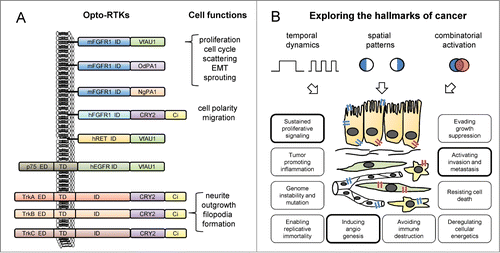Figures & data
Figure 1. Recently published optically controlled receptor tyrosine kinases (Opto-RTKs) and potential applications in cellular oncology. (A) Design principles of the first Opto-RTKs recently described by our groups in Austria and the group in Korea and accessible cellular functions. Manipulated RTKs include murine/human fibroblast growth factor receptor 1 (m/hFGFR1), human epidermal growth factor receptor (hEGFR), human ret proto-oncogene (hRET), and tropomyosin-related kinase A/B/C (TrkA/B/C). Activation was achieved through attaching light oxygen voltage (LOV) domains of V. frigida aureochrome 1 (VfAU1) or O. danica/N. gaditana putative aureochrome 1 (Od/NgPA1) to the intracellular domains (ID) of the receptors. Extracellular (ED) and transmembrane domains (TD) were either retained or removed. Fluorescent proteins such as mCitrine (Ci) can be further added to the protein. (B) Opto-RTKs can be used to test the effects of temporally or spatially defined signaling patterns on cancer-related functions. By (co-)expressing Opto-RTKs that respond to light of different color (depicted in blue and red) in specific cell types (e.g., epithelial cells, fibroblasts, endothelial cells, immune cells), an additional level of control can be achieved. Hallmark characteristics linked to cell functions that were manipulated by light via Opto-RTKs in the recent publications are highlighted.

